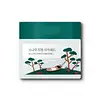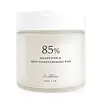What's inside
What's inside
 Key Ingredients
Key Ingredients

 Benefits
Benefits

 Concerns
Concerns

No concerns
 Ingredients Side-by-side
Ingredients Side-by-side

Pinus Densiflora Leaf Extract
AntimicrobialWater
Skin ConditioningPropanediol
SolventDipropylene Glycol
Humectant1,2-Hexanediol
Skin ConditioningCentella Asiatica Extract
CleansingBetaine
HumectantSodium Hyaluronate
HumectantButylene Glycol
HumectantCaprylyl Glycol
EmollientCentella Asiatica Leaf Extract
Skin ConditioningCinnamomum Camphora Leaf Extract
MaskingPanthenol
Skin ConditioningGlycoproteins
Skin ConditioningEthylhexylglycerin
Skin ConditioningDipotassium Glycyrrhizate
HumectantMelia Azadirachta Leaf Extract
Skin ConditioningMelia Azadirachta Flower Extract
Skin ConditioningMadecassoside
AntioxidantAsiaticoside
AntioxidantAsiatic Acid
Skin ConditioningMadecassic Acid
Skin ConditioningHydroxyacetophenone
AntioxidantGluconolactone
Skin ConditioningCapryloyl Salicylic Acid
ExfoliatingC12-14 Pareth-12
EmulsifyingSuccinic Acid
BufferingAmmonium Acryloyldimethyltaurate/Vp Copolymer
Sodium Citrate
BufferingPantolactone
HumectantDisodium EDTA
Pinus Densiflora Leaf Extract, Water, Propanediol, Dipropylene Glycol, 1,2-Hexanediol, Centella Asiatica Extract, Betaine, Sodium Hyaluronate, Butylene Glycol, Caprylyl Glycol, Centella Asiatica Leaf Extract, Cinnamomum Camphora Leaf Extract, Panthenol, Glycoproteins, Ethylhexylglycerin, Dipotassium Glycyrrhizate, Melia Azadirachta Leaf Extract, Melia Azadirachta Flower Extract, Madecassoside, Asiaticoside, Asiatic Acid, Madecassic Acid, Hydroxyacetophenone, Gluconolactone, Capryloyl Salicylic Acid, C12-14 Pareth-12, Succinic Acid, Ammonium Acryloyldimethyltaurate/Vp Copolymer, Sodium Citrate, Pantolactone, Disodium EDTA
Water
Skin ConditioningButylene Glycol
Humectant1,2-Hexanediol
Skin ConditioningGlycerin
HumectantPolyglyceryl-10 Laurate
Skin ConditioningPolyglyceryl-10 Myristate
Skin ConditioningEthylhexylglycerin
Skin ConditioningAnastatica Hierochuntica Extract
AstringentDipotassium Glycyrrhizate
HumectantAmmonium Acryloyldimethyltaurate/Vp Copolymer
Disodium EDTA
Allantoin
Skin ConditioningCitric Acid
BufferingCynanchum Atratum Extract
Skin ConditioningSodium Citrate
BufferingCitrus Tangerina Peel Oil
MaskingMalt Extract
Skin ProtectingArtemisia Vulgaris Oil
PerfumingRosmarinus Officinalis Leaf Oil
MaskingChamomilla Recutita Flower Oil
MaskingJuniperus Mexicana Oil
MaskingLavandula Angustifolia Oil
MaskingSodium Hyaluronate
HumectantHydroxypropyltrimonium Hyaluronate
Adansonia Digitata Seed Extract
Skin ConditioningAnthemis Nobilis Flower Extract
MaskingPortulaca Oleracea Extract
Skin ConditioningHydrolyzed Hyaluronic Acid
HumectantSodium Acetylated Hyaluronate
HumectantHyaluronic Acid
HumectantHydrolyzed Sodium Hyaluronate
Skin ConditioningOpuntia Ficus-Indica Stem Extract
Skin ConditioningSodium Hyaluronate Crosspolymer
HumectantPotassium Hyaluronate
Skin ConditioningLimonene
PerfumingWater, Butylene Glycol, 1,2-Hexanediol, Glycerin, Polyglyceryl-10 Laurate, Polyglyceryl-10 Myristate, Ethylhexylglycerin, Anastatica Hierochuntica Extract, Dipotassium Glycyrrhizate, Ammonium Acryloyldimethyltaurate/Vp Copolymer, Disodium EDTA, Allantoin, Citric Acid, Cynanchum Atratum Extract, Sodium Citrate, Citrus Tangerina Peel Oil, Malt Extract, Artemisia Vulgaris Oil, Rosmarinus Officinalis Leaf Oil, Chamomilla Recutita Flower Oil, Juniperus Mexicana Oil, Lavandula Angustifolia Oil, Sodium Hyaluronate, Hydroxypropyltrimonium Hyaluronate, Adansonia Digitata Seed Extract, Anthemis Nobilis Flower Extract, Portulaca Oleracea Extract, Hydrolyzed Hyaluronic Acid, Sodium Acetylated Hyaluronate, Hyaluronic Acid, Hydrolyzed Sodium Hyaluronate, Opuntia Ficus-Indica Stem Extract, Sodium Hyaluronate Crosspolymer, Potassium Hyaluronate, Limonene
 Reviews
Reviews

Ingredients Explained
These ingredients are found in both products.
Ingredients higher up in an ingredient list are typically present in a larger amount.
1,2-Hexanediol is a synthetic liquid and another multi-functional powerhouse.
It is a:
- Humectant, drawing moisture into the skin
- Emollient, helping to soften skin
- Solvent, dispersing and stabilizing formulas
- Preservative booster, enhancing the antimicrobial activity of other preservatives
Ammonium Acryloyldimethyltaurate/Vp Copolymer (let's call it AAVC for short) is a synthetically created polymer. It's used as a film-forming agent and used to thicken the consistency of products.
AAVC is able to increase the consistency and viscosity of products due to its large molecule size. It also prevents ingredients from separating.
Butylene Glycol (or BG) is used within cosmetic products for a few different reasons:
Overall, Butylene Glycol is a safe and well-rounded ingredient that works well with other ingredients.
Though this ingredient works well with most skin types, some people with sensitive skin may experience a reaction such as allergic rashes, closed comedones, or itchiness.
Learn more about Butylene GlycolDipotassium Glycyrrhizate comes from licorice root.
Extracts of licorice have demonstrated to have antibacterial, anti‐inflammatory, antiviral, antioxidant properties.
One component, glabridin, has extra potent antioxidant and soothing properties. It has also been found to block pigmentation from UVB rays in guinea pigs.
Licorice Root also contains a flavonoid. Flavonoids are a natural substance from in plants. Flavonoids also have antioxidant properties.
Another component, glycyrrhizin, has been found to have anti-inflammatory and antimicrobial benefits. This may make licorice root extract effective at treating acne. However, more research is needed to support this.
Liquiritin is one of the flavone compounds found in licorice. It has been found to help lighten skin by preventing tyrosinase from reacting with tyrosine. When the two react, protein is converted to melanin. Melanin is the substance in your body that gives your features pigmentation.
Licorice root is native to Southern Europe and Asia. It has been used in traditional Chinese medicine to help with respiratory issues.
Learn more about Dipotassium GlycyrrhizateDisodium EDTA plays a role in making products more stable by aiding other preservatives.
It is a chelating agent, meaning it neutralizes metal ions that may be found in a product.
Disodium EDTA is a salt of edetic acid and is found to be safe in cosmetic ingredients.
Learn more about Disodium EDTAEthylhexylglycerin (we can't pronounce this either) is commonly used as a preservative and skin softener. It is derived from glyceryl.
You might see Ethylhexylglycerin often paired with other preservatives such as phenoxyethanol. Ethylhexylglycerin has been found to increase the effectiveness of these other preservatives.
Sodium Citrate is the sodium salts of citric acid. In skincare, it is used to alter pH levels and acts as a preservative.
Its main functions are to maintain the pH of a product and neutralize metal ions.
The acidity of our skin is maintained by our glands and skin biome; normal pH level of skin is slightly acidic (~4.75-5.5).
Being slightly acidic allows our skin to create an "acid mantle". This acid mantle is a thin barrier that protects our skin from bacteria and contaminants.
Learn more about Sodium CitrateSodium Hyaluronate is hyaluronic acid's salt form. It is commonly derived from the sodium salt of hyaluronic acid.
Like hyaluronic acid, it is great at holding water and acts as a humectant. This makes it a great skin hydrating ingredient.
Sodium Hyaluronate is naturally occurring in our bodies and is mostly found in eye fluid and joints.
These are some other common types of Hyaluronic Acid:
Learn more about Sodium HyaluronateWater. It's the most common cosmetic ingredient of all. You'll usually see it at the top of ingredient lists, meaning that it makes up the largest part of the product.
So why is it so popular? Water most often acts as a solvent - this means that it helps dissolve other ingredients into the formulation.
You'll also recognize water as that liquid we all need to stay alive. If you see this, drink a glass of water. Stay hydrated!
Learn more about Water